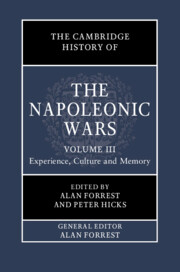Book contents
- The Cambridge History of the Napoleonic Wars
- The Cambridge History of the Napoleonic Wars
- The Cambridge History of the Napoleonic Wars
- Copyright page
- Contents
- Figures
- Maps
- Contributors to Volume III
- Introduction to Volume III
- Part I The Experience of War
- Part II The Experience of Imperial Rule
- Part III War, Culture and Memory
- 12 Memoirs and the Communication of Memory
- 13 Festivals, Ceremonies and Public Commemorations
- 14 The Portrayal of Heroism
- 15 The Fine Arts and the Napoleonic Wars
- 16 Poets and Novelists: Writing the Memory of War
- 17 Political Keyboard Music in Revolutionary and Napoleonic France: ‘The Battle’
- 18 The Napoleonic Wars in Caricature
- 19 The Napoleonic Wars in European Cinema
- 20 Nostalgia, or a Ruin with a View
- Part IV The Aftermath and Legacy of the Wars
- Bibliographic Essays
- Index
13 - Festivals, Ceremonies and Public Commemorations
from Part III - War, Culture and Memory
Published online by Cambridge University Press: 05 August 2022
- The Cambridge History of the Napoleonic Wars
- The Cambridge History of the Napoleonic Wars
- The Cambridge History of the Napoleonic Wars
- Copyright page
- Contents
- Figures
- Maps
- Contributors to Volume III
- Introduction to Volume III
- Part I The Experience of War
- Part II The Experience of Imperial Rule
- Part III War, Culture and Memory
- 12 Memoirs and the Communication of Memory
- 13 Festivals, Ceremonies and Public Commemorations
- 14 The Portrayal of Heroism
- 15 The Fine Arts and the Napoleonic Wars
- 16 Poets and Novelists: Writing the Memory of War
- 17 Political Keyboard Music in Revolutionary and Napoleonic France: ‘The Battle’
- 18 The Napoleonic Wars in Caricature
- 19 The Napoleonic Wars in European Cinema
- 20 Nostalgia, or a Ruin with a View
- Part IV The Aftermath and Legacy of the Wars
- Bibliographic Essays
- Index
Summary
In the seventeenth and eighteenth centuries, national ceremonies revolved around the throne, often on the occasion of state funerals. This was the case, for example, with the death of Marshal Turenne in 1675, when his body was placed in the Cathedral of St Denis, alongside the Bourbon kings of France. In such instances, it was a question of commemorating the ‘great men’ who had performed outstanding feats on behalf of the kingdom. The French Revolution turned this on its head by inventing a new political rhetoric and symbolism and by involving the people in public festivities to an unprecedented degree. National festivals were designed to draw the people together, originally around the idea of a constitutional monarchy, later, when that failed, around the Republic. It was no longer ‘great men’ who were celebrated but ‘the people’, who had become an integral part of the polity. Different fêtes civiques (civic festivals) were organised around a new guiding principle – the ‘sovereignty of the people’ – that could range from commemorating the assault on the Bastille to celebrating military victories or instituting a new kind of civic religion (such as the Festival of the Supreme Being in 1794).
- Type
- Chapter
- Information
- The Cambridge History of the Napoleonic Wars , pp. 260 - 278Publisher: Cambridge University PressPrint publication year: 2022



